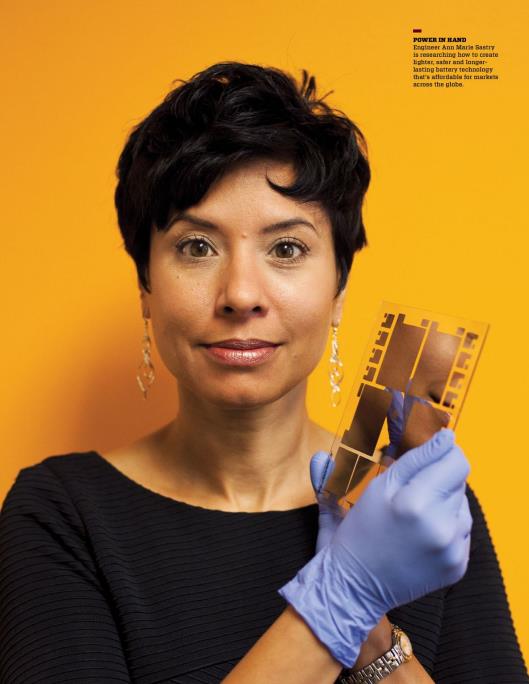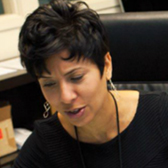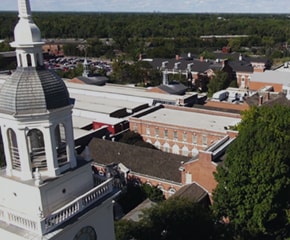
The Engineer
Ann Marie Sastry
The entrepreneur and battery maker says irrational optimism and a dose of derring-do inspire great innovation.
Ann Marie Sastry wants to put next-generation solid-state batteries in cars. And her company, Sakti, is right there in the race to be the first battery manufacturer to do it. But when you look a little closer, you’ll find there’s something special about Sastry’s approach to making electric vehicle batteries lighter, safer and longer-lasting. She isn’t actually interested in being the first to develop a product that works. Any one of the hundreds of start-up battery companies in today’s burgeoning clean tech sector with the right brains, brawn and financial fortitude can probably do that. Sastry wants to be the first to develop a product that works and that everyone can, and will, want to buy in hundreds of different markets around the world. (Catch the similarities to Henry Ford’s story and his lofty vision for the automobile 100+ years ago?) That means she wants her technology to:
- Be practical for established as well as emerging markets
- Be affordable across all socioeconomic ladders
- Generate new policy and infrastructure
- Create a new consumer experience that improves people’s lives along with the health of the planet
A perfect model of mass-production engineering, right? When The Henry Ford approached Sastry as part of its OnInnovation initiative, she spoke candidly about the growing competition to solve the electric vehicle’s battery problems and how you have to welcome the fight (aka the competition) if you really want to see the best solutions come forward. She also shared her thoughts about the importance of collaboration, being open to learning from unlikely sources and why most innovators—herself included—like the sensation they get when they take big gambles in hopes of solving the world’s biggest problems.
OI: Why start a company that makes advanced batteries for cars?
AMS: We know the markets for cars will dwarf those of today’s markets as people join the middle class all over Asia, Brazil, Russia, India, China, the BRIC nations. Those markets will be prodigious. What that means, then, is that there’ll be lots more people driving cars. It would be great if we could intercept those markets with electric vehicles rather than IC engines.

I’ve always been an electric vehicle fan, and when I was in research, I worked with a lot of different people on all kinds of problems in biology, in mathematics, in engineering physics and electric chemistry, but we kept coming back to batteries. We saw that as a key challenge, a key opportunity. If you can solve the battery problem, then you have a chance at getting electrification technologies on the road.
And in our case, a “terrible” thing happened when we tried to make batteries in the lab the way we thought they should be made—the first set worked. It’s always dangerous when a first set of things you try surprise and delight. That lightning strike led to a late-night conversation in the lab, and one of us said, “Well, we should just start a company.”
OI: What are some of the challenges of turning a scientific breakthrough into a commercial endeavor?
AMS: It turns out it’s pretty hard to start a company, but it’s also the most fun I’ve ever had. We could have just continued writing papers and wait for others to come along and license the technology or sort of follow the recipes we laid down. Or we could understand what the needs, industrially, in the markets were and try to meet them ourselves. And so we decided to spin out as a company and quickly connected with a venture capital group willing to fund us.
Besides the technology, the most important elements you have to have to warrant starting a company are the team and the markets. For the team, I wanted to bring like-minded people to Sakti to become trained in our ways and let them train us in theirs. That’s something every leader has to get comfortable with very quickly. When you search out outstanding people, not only will you acclimatize them—teach them your culture—but your culture will change when you bring them in. It’s a good thing.
But a great team isn’t enough if the markets aren’t there to ply your wares to, right? Vice versa, if you have the markets but an inadequate team, you may wind up selecting a lesser technology because you can’t execute the better one. You have to have both.
OI: Tell us how advanced battery technology works or maybe how you envision it should work?
AMS: In a car, you have to pay to carry around your own power supply. So you don’t want a technology that stores energy and is very heavy because you won’t be able to carry it. Energy density ends up being a very critical parameter. Lead-acid technology had a relatively low energy density. Nickel-metal hydride technology came around and approximately doubled that energy density. Lithium-ion technology approximately doubles that energy density. The reason you see teams like ours chasing second-generation lithium technologies is precisely so we can get to the next level—batteries that live longer, are lighter weight and safer.
What’s interesting to me is the bifurcation in battery technology. There are always the groups trying to make the world’s best. And there are groups trying to meet markets. What we don’t have enough of is groups trying to do what’s in the middle, which is improve technology, but in a way that you could put it into an engineered product. Why chase a particular nanoarchitecture, for example, that is very difficult to execute, make and deliver? We’ve picked a technology area that is massively replicable and massively scalable and, what we believe, can be optimized. We’ll see if our approach works. The area is ripe for innovation.
OI: Holding to cautious optimism then?
AMS: A couple of decades ago, I was a young composites researcher. Many of us who were working carbon-fiber technologies then just knew everyone was going to pick carbon-fiber composites. Guess what? Steel got better—much lighter, much cheaper—and in many cases beat out composite materials.
It would have been a mistake to rule out the older technology and assume innovations couldn’t occur.
I don’t think the dust will settle on the key propulsion systems in the next decade. I think that’ll take 50 years, and during that time, you will see the clean energy technologies duking it out in the marketplace, the labs, and in young and existing companies. And if you really care about the technology, if you really would like to see the best solutions come forward, you welcome the fight. And you never say, “Well, it’s absolutely going to be this or it’s absolutely going to be that.”
OI: How do you attract people with the skills and the will to fight the fight with you?
AMS: You have to create an environment where they feel, and it’s materially true, that they can change the environment. You have to accept that the most junior person and the most senior person will come to an organization and change its culture, and that’s good.
At Sakti, we not only expect mentorship of the most senior people chronologically, or in the age of experiment experience in better technologies, to the most junior people. We also expect the reverse—mentorship up and down the scales. I think this mentality builds a team. It creates less hierarchy and more collaboration.
I’ve had the good fortune to work with people who stretch themselves, take their credentials and fit them around any problem they want to work on. And when everybody is stretching, you really sort of see the bones of a really smart group, no matter how disparate its members may seem. You see everybody get their credentials, backgrounds and wattage around a problem. That’s great fun.
OI: How does the fun, the innovation, begin?
AMS: People have all kinds of ideas about how to innovate and what that means to them. I think the first thing is to pick a good problem. A problem where you know you’ll make a difference if you solve it. Know that it’s better to fail at something of consequence than to work on something of no consequence.
Vehicle electrification is a great problem. What’s the bottleneck? What’s preventing my favorite technology from hitting the road? I see several. Electric machines aren’t as good as they could be. Controls aren’t as good as they could be. Vehicles weigh too much; they’re too heavy for a reasonable propulsion system. But really, it’s about the battery. If we had better batteries, we could really open up this innovation space. If they were made of lighter weight materials. If we could make them live longer, because emerging economies don’t have the dealer networks we do. If we could make them in a way that is massively replicable to keep costs down. And we need to do this quickly, because a lot of people are about to buy cars.
You keep narrowing down the design space. Deciding to work on solid-state battery technology was sort of this cascade of decisions, guided innovation, for us.
OI: Guided innovation. An interesting term. Can you explain a little further?
AMS: In different areas of clean tech, groups are making choices based on—guided by—what they identify as the bottleneck. Talk to people innovating in this space, and they’re convinced that they are looking at the bottleneck, that they have picked the technology problem that “if I could just solve that one, it could upset the apple cart.” When it comes to the vehicle drivetrain and propulsion, some are looking at capacitors, others biofuels and diesel technologies and, even still, fuel cells. And that’s good.
All the innovators in these spaces that I have had the privilege to get to know have a certain irrational optimism and what goes along with that—a willingness to fail. You have to because you might get 50 percent of the way on logic, and then you have to place a huge bet and ask your team to follow you on your merry path to make a change. Just about every entrepreneur you talk to not only has had this sensation but likes this sensation—likes placing a bet and seeing if they can get a really great team together to chase a really great problem.
OI: You’re a mechanical engineer, a researcher, a professor and an entrepreneur recognized by Forbes as one of the nation’s top 12 women in clean tech. Can you share some of your biggest life lessons so far?
AMS: Never overlook an opportunity to learn from someone unexpected. Everyone has an axis of excellence. You have people who are wildly successful in a lot of spheres, and then there are some people you interact with that do one thing really well. It benefits you to study and learn from them, too.
Another big lesson: We think as a society that there are some people with that sort of bent, that they have “it”—the knack, the whatever, that the tinkerers have. That they like math, that they’re good at science. But there are many, many people who are gifted in math and science that never execute, who never do anything with their talents.
You have to access people’s motivation. If you can tap into someone’s desire to create change, it’s amazing what they can train themselves to do. You can put a challenge before smart people. You can give them the tools to execute. You can give them the team to help them execute. But nobody can dictate what a smart person does. You have to get to that motivation.
OI: Do you think there is still something about America and the American character experience that gives us an edge when it comes to new innovations?
AMS: Our nation is really good at producing innovators and innovations because we are able to attract people from all over the planet with that sort of derring-do. We can engage anybody from any socioeconomic level, any walk of life. What that means is that our teams, in whatever domain—engineering, entertainment, policy—tend to be very heterogeneous, and that’s extremely powerful.
I also think people plant feet here because they like the rules. You’re allowed to fail. Actually, failure is often a badge of honor. Look at the histories of great innovators; they’re often pockmarked with failure.
There are no social strata, no presumptions. There are no expectations that you should stay in your box, your bin, your stratum. In fact, it’s a point of pride for people that delta that gap of where you start and where you wind up. And it doesn’t matter whether you have your degrees, whether you studied physics at Oxford or received your technical degree from DeVry, if you end up a billionaire because you make a product that everybody wants.
Very improbable people have done very improbable things in America. I like to say it’s the club where people with ambition, derring-do and a desire to change things are welcome to join.
OI: And if someone wants to join this club, what would you suggest they do first?
AMS: If you want to go into a technology area with, metaphorically, guns blazing and really make a change, arm yourself with a good understanding of science, math and physics. Build strong engineering skills, because those skills give you a platform to create new processes and products that can profoundly change people’s lives.
This interview was originally published in the January-May 2014 issue of The Henry Ford Magazine.


